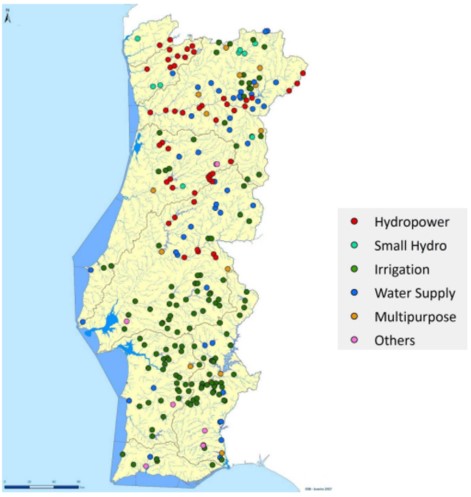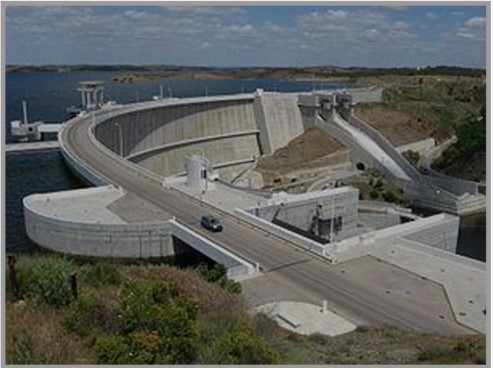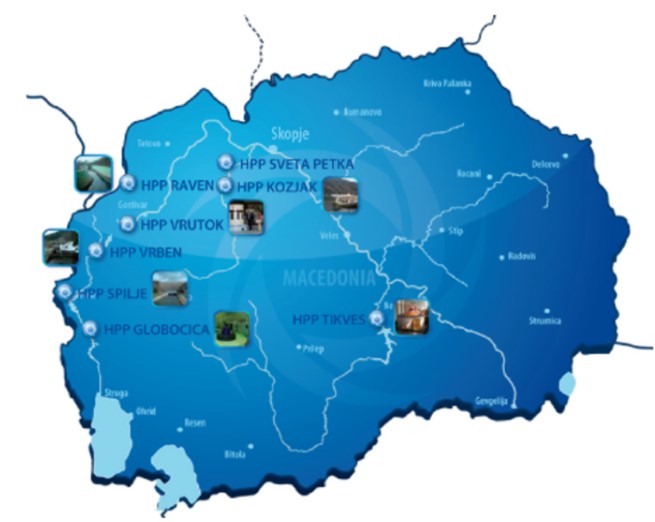- Definition and Types of Energy
- Myths And Misconceptions About Energy
- The Relationship Between Energy and Environment
- Climate Change and Carbon Footprint
- Greenhouse Gas Effect
- The Role of Human-Induced Greenhouse Gases and Energy Consumption
- Energy Efficiency and Sustainability
- Renewable Energy Sources and Future Perspectives
- Play and Learn
- Solar Energy Conversions
- Solar Energy Worldwide
- Solar Energy in Partner Countries
- Positive and Negative Impacts
- Technologies for Harnessing Solar Energy
- Solar thermal energy technologies and applications
- Electricity Generation Methods
- Passive Heating and Cooling of Residences with the Sun
- Concentrator solar power (CSP) systems and electricity generation
- Systems and Applications That Generate Electricity directly from solar rays
- Photovoltaic Cells and Panels
- Domestic PV Systems
- Off-Grid PV Systems
- Hybrid Connected Systems
- Materials Used in PV Cells
- Play and Learn
Hydraulic Energy in Partner Countries
Hydraulic Energy in Türkiye
The energy produced in small hydroelectric power plants (SHP) in Türkiye varies depending on the precipitation pattern. The amount of precipitation in our country varies according to the regions and seasons. Although Türkiye is not rich in terms of hydraulic potential, it is among the countries that can be self-sufficient by using its water resources effectively. Dam construction in Türkiye dates back to prehistoric times. The first dams were built by the Hittites in 1300 BC and the Urartians in 1000 BC. In the Republican period, the first dam was the Çubuk Dam, built in 1930 to meet the drinking water needs of Ankara. The Electrical Power Resources Research Administration (EİE) was established in 1932 to determine and research suitable energy sources for electricity production. In 1950, Türkiye's installed electrical power was 408 MW and its hydroelectric capacity was only 18 MW. However, a significant increase was achieved in the number of hydroelectric power plants until the 1970s. The development of hydroelectric energy in Türkiye gained momentum with the establishment of the Turkish Electricity Authority (TEK) in 1970. With TEK, the construction of power plants by official institutions and municipalities was stopped and a transition to an interconnected system was provided throughout the country. During the same period, the private sector was involved in the construction of hydroelectric power plants. With the law enacted in 1984, the participation of the private sector in electricity production was encouraged with the Build-Operate-Transfer (BOT) model.

In order to regulate the hydroelectric energy market, the Energy Market Regulatory Authority (EPDK) was established in 2001 and the authorities of electricity production, transmission and distribution were transferred to this institution. After 2003, the "Water Use Regulation" was published to encourage private sector investments, and the Renewable Energy Law (YEK) was enacted in 2005. With the regulations made in 2011, the installation of small-scale micro and mini hydroelectric power plants was facilitated. Türkiye has the capacity to build all types of hydroelectric power plants in terms of technology. One of the best examples of this is the Atatürk Dam and Hydroelectric Power Plant, which was largely built by domestic companies. Our country has the necessary technology and investor potential for the installation of small and medium-scale hydroelectric power plants. Especially compared to large-scale hydroelectric power plants, KHES projects, which can be built faster and have fewer legal/financial obligations, are attracting more attention from the private sector. Today, the number of hydroelectric power plant projects carried out by the private sector within the framework of the Electricity Market Law No. 4628 is approximately 1,595. However, the increase in private sector investments has also brought with it some problems. The uncontrolled transfer of many streams to the private sector through "Water Usage Rights Agreements" has created risks that could lead to deterioration in water quality and increases in water prices. Therefore, it is important to develop more balanced policies in the use of hydraulic energy, considering sustainability and public interest.
As of the end of 2024, Türkiye's total installed capacity has reached 115,975 MW, 32,203 MW of which consists of hydroelectric power plants (HES). This value corresponds to approximately 27.8% of the total installed capacity. The number of hydroelectric power plants is also striking. As of the end of December 2024, there are a total of 784 HES in Türkiye; 617 of them are fluvial type and 147 are dam type.
Hydraulic Energy in Portugal
In Portugal, like in most countries, small hydraulic structures to transform water movement or potential energy into useful energy have been used for thousands of years.
The construction of big dams to control water fluxes and/or for hydroelectric production of electricity began by the end of the 19th century but became significant in the mid-20th century. In 2007, Portugal launched the National Program for Dams with High Hydroelectric Potential (PNBEPH), which led to a substantial increase in the country’s installed capacity.

Even if the country has 260 big dams (more than 15 m height or 10-15 m height and 1 hm3 of capacity), most of them are dedicated to agriculture, water regulation and other activities. Actually, Portugal has 42 hydroelectric power plants (> 10 MW), and about 8.2 GW of total installed capacity, from which about one third is due to pumping systems. Due to the strong asymmetries in orography and precipitation patterns between the North and the South of Portugal, the dams for hydroelectric use are mostly located in the north of the country. With the explosive growth of other forms of renewable energies in the last two decades, hydroelectric power plants became even more important once they could contribute to the stabilization of the electricity grid, in particular after the closing of all the coal-based power plants in Portugal.
One of the largest dams in Portugal is the Alqueva dam (figure), built on the Guadiana River and inaugurated in 2004. It gave rise to the largest artificial lake in Europe and allows the irrigation of immense agricultural areas in the south of Portugal. It has an installed hydroelectric power of 240 MW. The largest hydroelectric plant in Portugal is the Gouvães dam, on the Torno River, in the Douro River basin, with 880 MW of installed capacity.

Hydraulic Energy in Greece
Greece, a predominantly mountainous country with over 80% of its land covered by mountains, particularly in the northwestern regions, is well-suited for hydropower development. The country's mountainous terrain, coupled with numerous rivers, provides ideal conditions for the harnessing of hydraulic energy. Greece’s annual theoretical hydropower potential is estimated at approximately 80 TWh, which presents a significant opportunity for electricity generation from water resources. Historically, Greece has made use of its watercourses for various purposes, and the modern exploitation of hydropower began in the early 20th century, with the establishment of the first hydroelectric plants.
Hydropower plays a notable role in Greece's energy landscape. As of 2023, hydropower accounted for 13% of the country’s total installed power generation capacity and 10% of total power generation. In that year, Greece’s hydropower capacity reached 3,427 megawatts, a slight increase from 3,421 megawatts in 2022. While Greece’s hydropower potential is substantial, the energy production is subject to seasonal and climatic fluctuations, as well as varying precipitation levels. Therefore, the contribution of hydropower to the national grid can be impacted by extended periods of drought or uneven rainfall.
Over the years, Greece has made significant strides in hydropower development. The establishment of the Public Power Corporation (PPC) in the 1950s spurred the growth of the country’s energy sector, and hydropower was central to this expansion. In the decades that followed, Greece focused on developing its capacity to generate renewable energy, with hydropower serving as one of the main contributors to the national energy mix. However, as the country’s energy needs grew, so did its reliance on other sources, such as natural gas and renewable energy technologies like wind and solar power.
In recent years, the Greek government has worked to encourage the development of small and medium-scale hydropower plants, recognizing the importance of these renewable sources for the country’s energy security. The liberalization of the energy market and the introduction of regulatory frameworks to promote private investment have led to an increase in hydropower projects, particularly in remote or mountainous regions where the hydropower potential is more easily accessible. Despite these developments, concerns regarding the environmental impact of new hydropower projects have surfaced, especially in terms of river ecosystems, biodiversity, and local communities.

As of 2024, Greece's total installed electrical capacity stands at approximately 18,000 MW, with hydropower contributing about 3,427 MW of this total. The country currently operates around 250 hydroelectric plants, including large-scale dams and smaller run-of-the-river plants. While hydropower’s contribution to Greece’s energy mix is significant, the government continues to focus on ensuring a balance between energy development and environmental sustainability. In the coming years, Greece will need to carefully manage its hydraulic energy resources to meet future energy demands while safeguarding the country’s natural water systems.
Hyraulic Energy in North Macedonia
North Macedonia's mountainous terrain and numerous rivers provide a substantial foundation for hydroelectric power generation. The country's theoretical hydroelectric resources are estimated at approximately 8.863 TWh annually, though current production is about 1.2 TWh, indicating significant untapped potential.
The development of hydroelectric power in North Macedonia dates back several decades. The Mavrovo Hydropower System, one of the largest and most complex in the country, comprises three power plants: Vrutok, Vrben, and Raven. Collectively, they have an installed capacity of 200 MW and an annual electricity production of approximately 445 GWh.
Another notable facility is the Tikveš Hydroelectric Power Station, located on the Crna River. With a capacity of 113 MW, it has been operational since 1968, contributing significantly to the nation's hydroelectric output.
Recognizing the importance of hydroelectric power in its energy mix, North Macedonia has initiated several projects to modernize and expand its hydroelectric infrastructure. In February 2023, financing agreements totaling €36.2 million were signed for the rehabilitation of six major hydroelectric plants: Vrutok, Vrben, Raven, Tikveš, Globočica, and Špilje. These plants account for approximately 85% of the country's hydroelectric capacity and contribute about 20% to its total electricity production.
Additionally, the government has awarded a concession for the construction of the Čebren Hydroelectric Plant, a 333 MW pumped storage facility on the Crna River. This project aims to enhance the country's renewable energy capacity and provide greater flexibility in energy storage and distribution.

Beyond large-scale projects, North Macedonia has seen a proliferation of small hydropower plants. Since 2010, over 100 small hydropower plants have become operational, reflecting the country's commitment to diversifying its renewable energy sources.
The government continues to invite investments in the energy sector, particularly in designing, building, and operating new hydroelectric plants. This strategy aligns with North Macedonia's goals to enhance energy security, reduce reliance on fossil fuels, and meet its renewable energy targets.
In conclusion, hydroelectric power remains a cornerstone of North Macedonia's energy strategy. Through modernization of existing facilities and development of new projects, the country aims to fully harness its hydroelectric potential, contributing to a sustainable and resilient energy future.